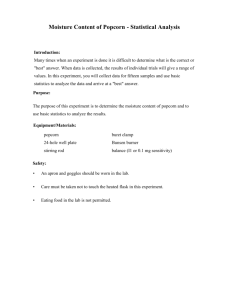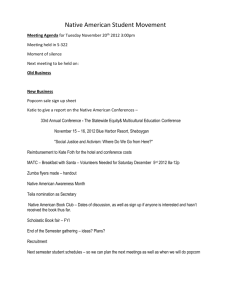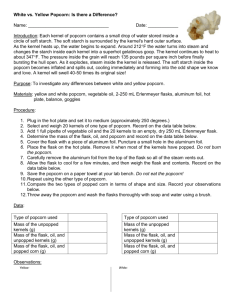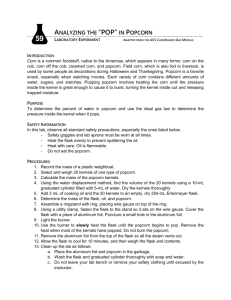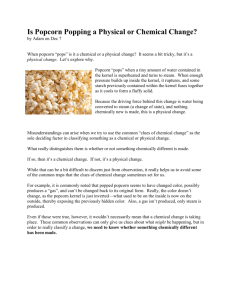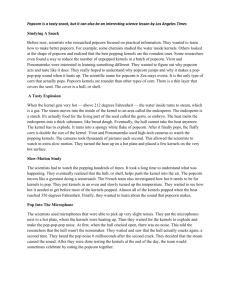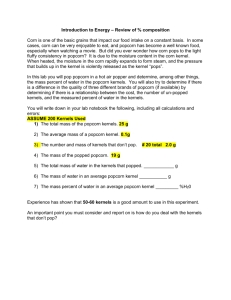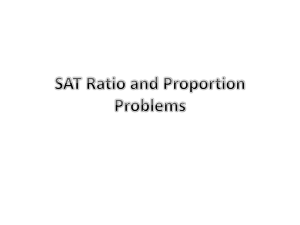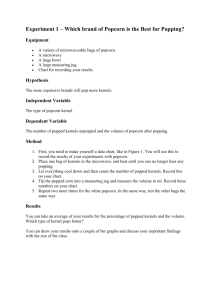Exploding Corn Lab
advertisement
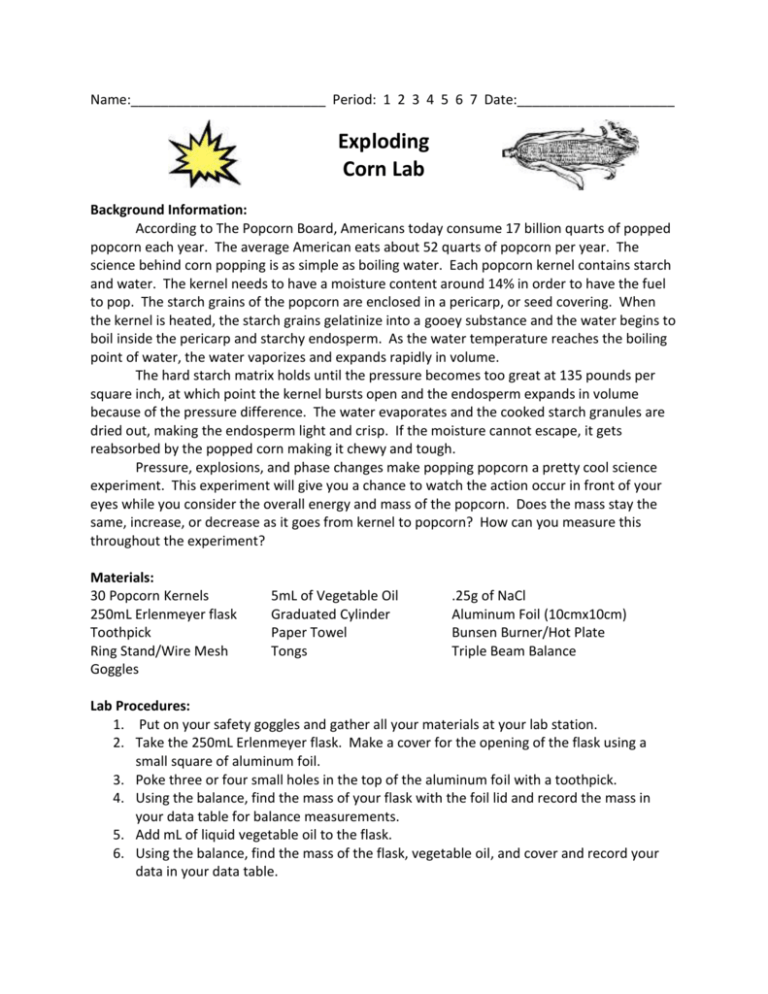
Name:__________________________ Period: 1 2 3 4 5 6 7 Date:_____________________ Exploding Corn Lab Background Information: According to The Popcorn Board, Americans today consume 17 billion quarts of popped popcorn each year. The average American eats about 52 quarts of popcorn per year. The science behind corn popping is as simple as boiling water. Each popcorn kernel contains starch and water. The kernel needs to have a moisture content around 14% in order to have the fuel to pop. The starch grains of the popcorn are enclosed in a pericarp, or seed covering. When the kernel is heated, the starch grains gelatinize into a gooey substance and the water begins to boil inside the pericarp and starchy endosperm. As the water temperature reaches the boiling point of water, the water vaporizes and expands rapidly in volume. The hard starch matrix holds until the pressure becomes too great at 135 pounds per square inch, at which point the kernel bursts open and the endosperm expands in volume because of the pressure difference. The water evaporates and the cooked starch granules are dried out, making the endosperm light and crisp. If the moisture cannot escape, it gets reabsorbed by the popped corn making it chewy and tough. Pressure, explosions, and phase changes make popping popcorn a pretty cool science experiment. This experiment will give you a chance to watch the action occur in front of your eyes while you consider the overall energy and mass of the popcorn. Does the mass stay the same, increase, or decrease as it goes from kernel to popcorn? How can you measure this throughout the experiment? Materials: 30 Popcorn Kernels 250mL Erlenmeyer flask Toothpick Ring Stand/Wire Mesh Goggles 5mL of Vegetable Oil Graduated Cylinder Paper Towel Tongs .25g of NaCl Aluminum Foil (10cmx10cm) Bunsen Burner/Hot Plate Triple Beam Balance Lab Procedures: 1. Put on your safety goggles and gather all your materials at your lab station. 2. Take the 250mL Erlenmeyer flask. Make a cover for the opening of the flask using a small square of aluminum foil. 3. Poke three or four small holes in the top of the aluminum foil with a toothpick. 4. Using the balance, find the mass of your flask with the foil lid and record the mass in your data table for balance measurements. 5. Add mL of liquid vegetable oil to the flask. 6. Using the balance, find the mass of the flask, vegetable oil, and cover and record your data in your data table. 7. Place 30 kernels of popcorn in a small graduated cylinder. Record the approximate volume of the kernels in your data table. 8. Carefully remove the cover from the flask and add the 30 kernels to the flask. 9. Using the balance, find the mass of the flask, foil cover, vegetable oil, and popcorn kernels and record that mass in your data table. 10. Set up a Bunsen burner and ring stand with wire mesh on the iron ring. Make sure your Bunsen burner gas intake tube is securely connected to the gas nozzle and that the ring is set about 3 in. above the barrel of the burner. Light the Bunsen burner to create a flame that is no more than 3 in. high. 11. Using the tongs, move the flask across the flame to evenly heat the popcorn kernels. 12. As the popcorn kernels burst, remove the flask from the heat and then heat only gently to pop the remaining kernels. Some kernels may not pop, so take care not to burn the popcorn. What do you observe inside the flask as the kernels are popping? Record your observations here? 13. Allow the flask to cool to room temperature. Use the balance to find the mass of the flask, lid, and contents and record your data. 14. Record the approximate volume of your popcorn kernels by using the measurement scale on the side of your Erlenmeyer flask. 15. Compare your results with another lab group in the class. Record the other data on your chart in the section called “Results From Other Scientists.” 16. Pour your popcorn onto a paper towel. Sprinkle with NaCl for taste, and then feel free to eat your final lab product. 17. Clean up your lab table and answer the follow up lab questions. Data Table My Results (g) Results from Other Scientists (g) My Results (mL) Results from Other Scientists (mL) Mass of Flask and Cover Mass of Oil, Flask, and Cover Mass of Flask, Cover, Oil, and Popcorn Kernels Mass of Flask, Cover, Oil, and Popcorn Kernels After Heat Expansion Volume of Popcorn Before Heating Volume of Popcorn After Heat Expansion Post-Lab Questions 1. What was the overall mass of oil used for your experiment? Calculate this using your measurements from your data table. 2. What was the mass of the popcorn kernels used in this experiment? Use your measurements from your data table and the answer to question #1 to figure this out. 3. What was the mass of the popcorn kernels once they were popped? Use the measurements from your data table to solve this problem. 4. What was the change in volume of the popcorn from kernel to when it popped? 5. Why do you think that some of the popcorn kernels did not pop? 6. How does this lab relate to the conservation of mass law? (Use at least 4 complete sentences to answer) 7. How do your results compare with the information you received from other groups? Were your results the exact same as other groups or different? Explain your answer?
